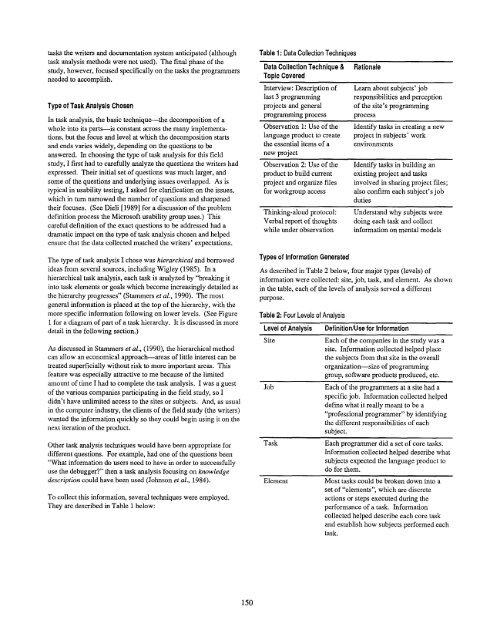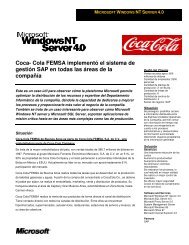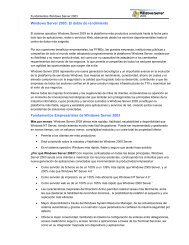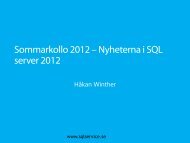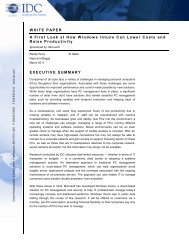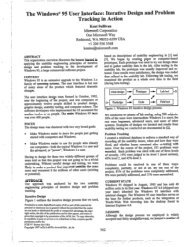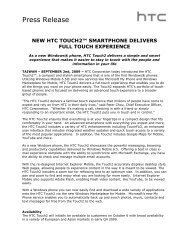Using Task Analysis in Documentation Field Research - Microsoft
Using Task Analysis in Documentation Field Research - Microsoft
Using Task Analysis in Documentation Field Research - Microsoft
You also want an ePaper? Increase the reach of your titles
YUMPU automatically turns print PDFs into web optimized ePapers that Google loves.
tasks the writers and documentation system anticipated (ahhough<br />
task analysis methods were not used). The f<strong>in</strong>al phase of the<br />
study, however, focused specifically on the tasks the programmers<br />
needed to accomplish.<br />
Type of <strong>Task</strong> <strong>Analysis</strong> Chosen<br />
Ju task analysis, the basic technique-the decomposition of a<br />
whole <strong>in</strong>to its parts-is constant across the many implementat-<br />
ions, but the focus and level at which the decomposition starts<br />
and ends varies widely, depend<strong>in</strong>g on the questions to be<br />
answered. In choos<strong>in</strong>g the type of task analysis for this field<br />
study, I first had to carefully analyze the questions the writers had<br />
expressed. Their <strong>in</strong>itial set of questions was much larger, and<br />
some of the questions and underly<strong>in</strong>g issues overlapped. As is<br />
typical <strong>in</strong> usability test<strong>in</strong>g, I asked for clarification on the issues,<br />
which <strong>in</strong> turn narrowed the number of questions and sharpened<br />
their focuses. (See Dieli [1989] for a discussion of the problem<br />
def<strong>in</strong>ition process the <strong>Microsoft</strong> usability group uses,) This<br />
careful def<strong>in</strong>ition of the exact questions to be addressed had a<br />
dramatic impact on the type of task analysis chosen and helped<br />
ensure that the data collected matched the writers’ expectations.<br />
The type of task analysis I chose was hierarchical and borrowed<br />
ideas from several sources, <strong>in</strong>clud<strong>in</strong>g Wigley (1985). In a<br />
hierarchical task analysis, each task is analyzed by “break<strong>in</strong>g it<br />
<strong>in</strong>to task elements or goals which become <strong>in</strong>creas<strong>in</strong>gly detailed as<br />
the hierarchy progresses” (Stammers et rd., 1990). The most<br />
general <strong>in</strong>formation is placed at the top of the hierarchy, with the<br />
more specific <strong>in</strong>formation follow<strong>in</strong>g on lower levels. (See Figure<br />
1 for a diagram of part of a task hierarchy. It is discussed <strong>in</strong> more<br />
detail <strong>in</strong> the follow<strong>in</strong>g section.)<br />
AS discussed <strong>in</strong> Stammers et al., (1990), the hierarchical method<br />
can allow an economical approach-areas of little <strong>in</strong>terest can be<br />
treated superficially without risk to more important areas. This<br />
feature was especially attractive tome because of the limited<br />
amount of time I had to complete the task analysis. I was a guest<br />
of the various companies participat<strong>in</strong>g <strong>in</strong> the field study, so I<br />
didn’t have unlimited access to the sites or subjects. And, as usual<br />
<strong>in</strong> the computer <strong>in</strong>dustry, the clients of the field study (the writers)<br />
wanted the <strong>in</strong>formation quickly so they could beg<strong>in</strong> us<strong>in</strong>g it on the<br />
next iteration of the product.<br />
Other task analysis techniques would have been appropriate for<br />
different questions. For example, had one of the questions been<br />
“What <strong>in</strong>formation do users need to have <strong>in</strong> order to successfislly<br />
use the debugger?” then a task analysis focus<strong>in</strong>g on knowledge<br />
description could have been used (Johnson et al., 1984).<br />
To collect this <strong>in</strong>formation, several techniques were employed.<br />
They are described <strong>in</strong> Table 1 below:<br />
150<br />
Table 1: DataCollectionTechniques<br />
Data Collection Technique & Rationale<br />
Topic Covered<br />
Interview: Description of Learn about subjects’ job<br />
List 3 programm<strong>in</strong>g responsibilities and perception<br />
projects and general of the site’s programm<strong>in</strong>g<br />
programm<strong>in</strong>g process r.wocess<br />
Observation 1: Use of the Identify tasks <strong>in</strong> creat<strong>in</strong>g a new<br />
language product to create project <strong>in</strong> subjects’ work<br />
the essential items of a environments<br />
new project<br />
Observation 2 Use of the Identify tasks <strong>in</strong> build<strong>in</strong>g an<br />
product to build current exist<strong>in</strong>g project and tasks<br />
project and organize files <strong>in</strong>volved <strong>in</strong> shar<strong>in</strong>g project files;<br />
for workgroup access also confirm each subject’s job<br />
Th<strong>in</strong>k<strong>in</strong>g-aloud prOtOCOk<br />
Verbal report of thoughts<br />
while under observation<br />
Types of Information Generated<br />
duties<br />
Understand why subjects were<br />
do<strong>in</strong>g each task and collect<br />
<strong>in</strong>formation on mental models<br />
As described <strong>in</strong> Table 2 below, four major types (levels) of<br />
<strong>in</strong>formation were collected: site, job, task, and element. As shown<br />
<strong>in</strong> the table, each of the levels of analysis served a different<br />
purpose.<br />
Table 2: FourLevelsof <strong>Analysis</strong><br />
Level of <strong>Analysis</strong> Def<strong>in</strong>ition/Use for Information<br />
Site Each of the companies <strong>in</strong> the study was a<br />
site, Information collected helped place<br />
the subjects from that site <strong>in</strong> the overall<br />
organization-size of programm<strong>in</strong>g<br />
group, softwwe products produced, etc.<br />
Job Each of the programmers at a site had a<br />
specific job. Information collected helped<br />
def<strong>in</strong>e what it really meant to be a<br />
“professional programmer” by identify<strong>in</strong>g<br />
the different responsibilities of each<br />
subject,<br />
<strong>Task</strong> Each programmer did a set of core tasks.<br />
Information collected helped describe what<br />
subjects expected the language product to<br />
do for them.<br />
Element Most tasks wuld be broken down <strong>in</strong>to a<br />
set of “elements”, which are discrete<br />
actions or steps executed dur<strong>in</strong>g the<br />
performance of a task. Information<br />
collected helped descnhe each core task<br />
and establish how subjects performed each<br />
task.


